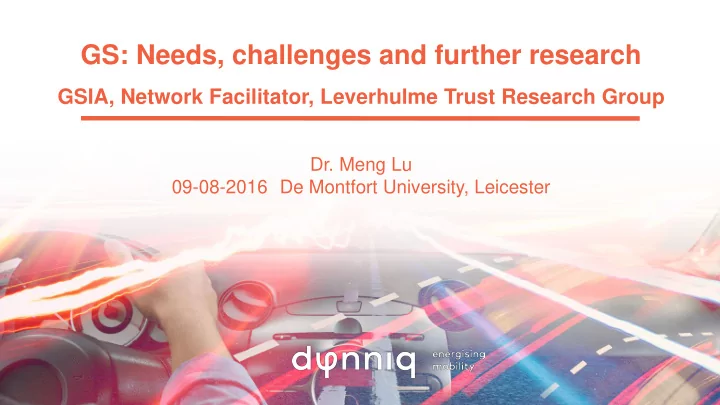

GS: Needs, challenges and further research GSIA, Network Facilitator, Leverhulme Trust Research Group Dr. Meng Lu 09-08-2016 De Montfort University, Leicester
Dynniq profile • Dutch owned & headquartered • Established for over 80 years • Present in 13 countries e.g. NL, UK, IE, BE, FI, SE, DK, PO, Baltics, US, CA, BR • Revenues: approx. 350M € (2015) • People: approx. 1800 employees globally Dynniq stands for dynamic, intelligent and innovative 14/06/2016 2
Markets We provide intelligent Our innovative parking We have specialised technology solutions that solutions help your business knowledge in energy support safe and efficient run smoothly with reliable technology, smart metering mobility for people and systems and equipment that and medium and high goods. ensure optimal security and voltage systems. flexibility.
Grey system overview • Grey system was initiated by J. Deng in 1982 in CN; provides an approach for abstract modelling of systems for which the information is limited, incomplete and characterised by random uncertainty, initially applied in systems and control. o Deng pioneered a unique theory for modeling, and decision when the data is sparse. o His contribution is greatly appreciated. This does not imply that we accept everything developed by him or his school. o Grey theory does not have solid mathematical foundations yet like probability theory, fuzzy theory (based on Credibility Measure) and others. Theoretical studies have been investigating in the past decades. • The first major breakthrough of Grey System (after the initiation of Deng) was made recently by Yang [2014], who determined grey numbers and grey sets, and also distinguished these with fuzzy sets and rough sets. 4
Pending issues need to be (further) studied and convincingly clarified • What are the relationships between grey numbers/sets and GM, and GRA respectively? • What are the relationships between GM and GRA based on the definitions of grey numbers and grey sets? • What is the main objective or scope of grey system, e.g. limited data vs. big data? why? how to determine the scope? • What are the unique usefulness and contribution of grey system in application that are different from other methods? 5
Uncertainty modeling topics in traffic and transport • Uncertainties in world trade and impacts on logistics market (forecasting) • Dynamic traffic management and control (nodes, links, network) • Shock waves and traffic jams mitigation (especially on highway) • Estimated Arrival Time • (Dynamic) route guidance (all modes) 6
Conclusion • Grey system has a multidisciplinary character to cope with the uncertainty of a system by using elements of relational analysis, operational research, system control, system modelling, system forecasting • Most distinguished methods: GRA and GM • Theoretical foundations are missing o Grey system or grey systems? In the latter case, what are the systems? o Relationships between grey number and grey system(s), GRA and GM? • Usefulness/value of the grey methods is unclear o What are the unique contribution of grey method(s), e.g. other methods (such as traditional systems and control, fuzzy set and fuzzy logic, other normalisation based evaluation methods) cannot do better? o In practice, why and how grey methods can better handle uncertainties? How these have been validated? 7
Recommend
More recommend